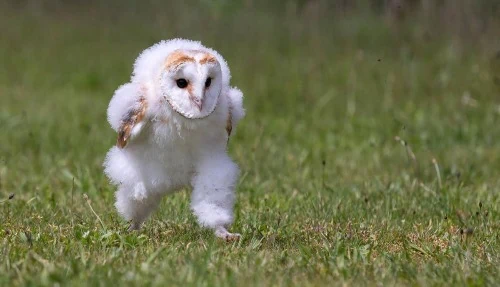Remember Hedwig from the Harry Potter Franchise? That was the first owl that piqued my interest. Generally, though, owls are eccentrically captivating.
Owls have also been tagged the sage of the avian world due to their acute senses and excellent sound localization. Luckily, they aren’t all rare.
So, as a birder in Massachusetts, you’ve probably ‘bumped’ into one during your birding trips. However, the eclectic mix of species in MA makes it impossible to keep up.
What are the owls in Massachusetts? Ready to learn the answer to these questions? Let’s look into Massachusetts owls.
Owl Species in Massachusetts
1. Great Horned Owls

The Great Horned Owl is a common species in North America and the Northeastern region, especially Massachusetts. This raptor adapts to any habitat, including cities, deserts, forests. Or wherever there’s the availability of trees and nesting sites—preferably a rocky one.
Their appearance is the quintessential Owls in mystical novels due to their massive size and ferocious look. The ear tufts on their heads scream “ I’m the Great Horned Owl!”.
Their eyes are absolutely intimidating.
Male and female Great Horned Owl hoots; however, the males' hoot isn’t as high pitched as the females. This common owl hunts large animals because they have to sustain their large bodies. Hence, other bird species, raptors, rabbits, geese, and groundhogs are on their food list. These don’t exempt smaller animals like insects, invertebrates, and reptiles.
Strangely enough, though, the Great Horned Owl has a terrible sense of smell.
It’s quick to get comfortable in other species’ abandoned nests. Sometimes, this owl lines the nest with feathers, bark, leaves, and pellets to make it cozier.
Pro Tip: You could provide this owl with its own abode by purchasing any of the best birdhouses available online or in-store. This will make the bird feel more at ease and secure.
2. Snowy Owl

The Snowy Owl has a striking white plumage, which has a charming effect on people. It's gorgeous!
They aren’t entirely white. Their bodies, except the breast and face, are marked with horizontal lines. Although you can spot a Snowy Owl in Massachusetts during winter, it’s rare.
This avian is migratory. So, it changes location depending on the weather. It mates and breeds in the north during summer and migrates to the south some winter.
Snowy Owls are mostly quiet. Their females hardly make any noises besides subtle shrieks, hisses, and crackles. But the males, in addition to these noises, hoot loudly while breeding or marking territories.
Being a diurnal avian, this owl hunts in broad daylight. It eats birds, waterfowl, and some small mammals and while wintering in the south, they feast on rabbits, rodents, and geese.
3. Barn Owl

When you sight an owl with heart-shaped, dark eyes against a distinctly white face, that’s a barn owl.
This medium-sized owl has a smooth head without any ear turfs sticking out and a short tail with lengthy wings.
The barn owl's plumage is a mix of gray and buff. So, you can’t mistake a Barn Owl for another species.
This owl species has amassed several nicknames over time. Monkeyface, church owl, whichever you choose to call it, you’d find it in Massachusetts throughout the year.
The Church Owl’s uniquely shaped face steers sound to its ears, making its sense of sound sharp-witted. Hence, It hunts bats and locates small animals hoarded in dense forests.
This raptor inhabits abandoned structures like barns, hence, the name. They’re nocturnal like most owls. So, they hunt in open coastal marshes at night. The Barn Owl has a peculiar screechy sound that almost mimics the Red Tailed Hawk.
4. Barred Owl
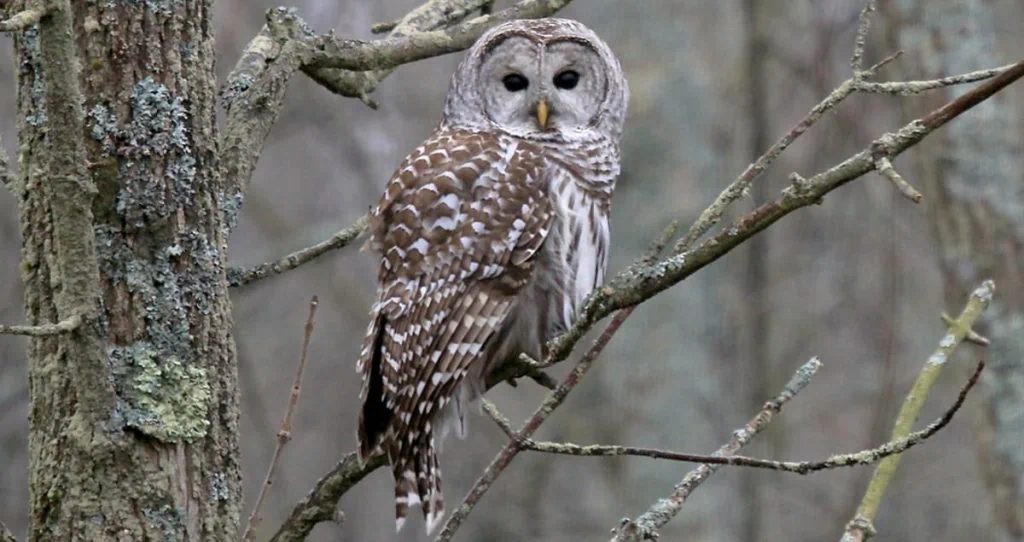
The Barred Owl’s hoo call is a familiar sound in Massachusetts all year round except in the southeastern region.
A sound so distinct that it sounds like a jarring question: Who cooks for you? Who cooks for you? Being up the ladder in the food chain sure has the universe cooking for it.
The Barred Owl is large. So, they’ll gladly pounce on mice, bats, squirrels, weasels, minks, snakes, an array of bird species, and any small mammals. But the Great Horned Owls remain their predators.
This bird’s name reflects the black and mottled brown bar-like horizontal stripes all over its body. Its chest has vertical lines.
You’re more likely to find them in forests near a water source, where it nests in tree cavities. Barred owls are inquisitive species, too. If you visit their habitat, then you could become an object of their inquisition. That means more up-close views for you!
5. Great Gray Owl
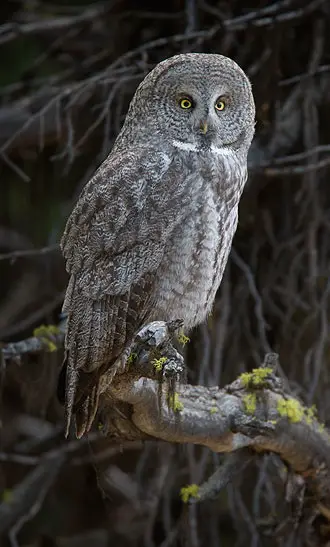
At 33 inches, the Great Gray Owl is larger than most owls of Massachusetts. Great Gray owl sighting is an incredible experience. This owl’s plumage looks like a gray suit and a bow tie.
It devours up to 7 rodents in a day! As expected, it hunts extensively to satisfy its rapacious appetite.
This avian resides in forests close to a clearing. The clearing serves as a hunting ground in winter, where it listens for prey under the snow before attacking.
Great Gray Owl doesn't excavate a nest. Instead, it relies on nests weaved by other large avians. And once it secures a nest, protects it jealously.
Pro Tip: You could custom-build a best owl nesting box for this huge bird using quality materials from your local DIY shop.
Its calls sound more like "woo-woo-woo!" The call is unmistakable: it’s one of the best ways to locate one. Gray Owl makes a more subtle hoot sound while defending territories.
6. Eastern Screech Owl
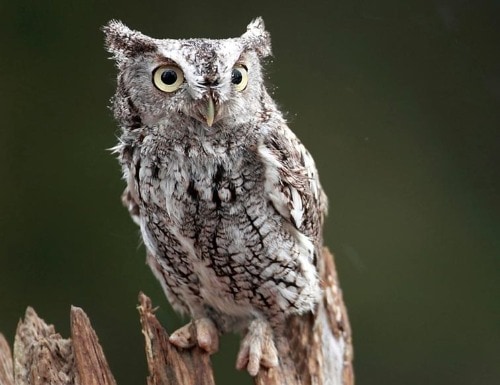
Eastern Screech Owl is one of the few types of owls in Massachusetts with conspicuous ear tufts. These tufts are camouflage; however. These owls have their ears parallel to their eye line under their feathers.
This owl is stocky and short, with almost no neck. Eastern Screech Owl could be hoary or reddish-brown. The ear tufts lend a distinctive silhouette to its head.
It can reside in any wooded area in Massachusetts. But it avoids sharing habitat with mammoth owls of Massachusetts, especially the Great Horned.
In most cases, the Screech Owl is acclimated to people. Hence, it adorns street lamps or buildings with its nest.
Despite having several hoots and calls, it has one popular one called the tremolo. This call lasts for about 6 seconds, and its sole purpose is to connect pairs.
It hunts at dusk, dawn, and mostly at night when it devours small animals, including mammals, birds, reptiles, and insects.
7. Long Eared Owl

This raptor migrates to Massachusetts from North America and Canada after breeding season. I like to describe this owl as secretive since it roosts in dense vegetation.
A Long Eared Owl sighting is laborious. When you do see one, it has long and notable feather tufts on its head. These tufts look like exclamation marks, giving the owl a permanently surprised expression.
This owl is by far one of the most social owl species. It shares roosts and is famous for living in clusters.
Since the Long Eared Owl is a rare sight, you may want to listen out for its long hoo sounds. Luckily, these birds aren’t secretive with their sounds during breeding seasons. The males call, repeatedly from 10 to about 200 times with short breaks.
This species sports brown and black feathers with yellow eyes affixed to a buff face. The Long Eared owl's prey includes rabbits, rats, voles, and other small mammals.
8. Northern Saw Whet Owl
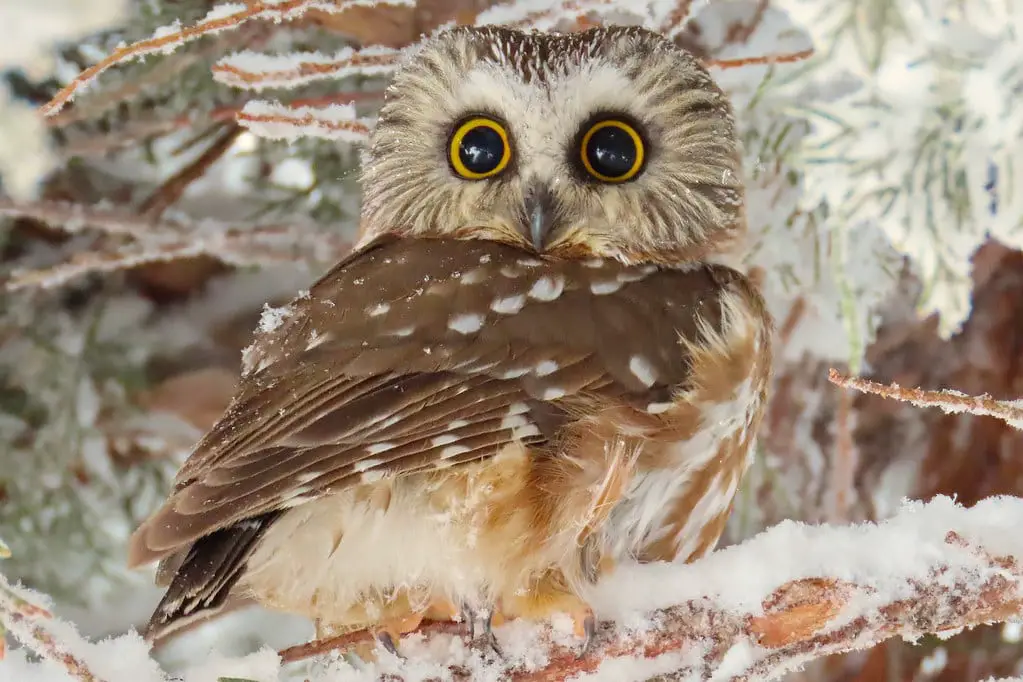
Of all the Massachusetts owls, Northern Saw Whet Owl is one of the smallest.
However, it has a peculiar choice of habitat leading to its decline. The owl resides in hardwood forests or dense coniferous trees close to a river.
Northern Saw Whet Owls use holes carved by woodpeckers' nests. It also relies on artificial nest boxes.
The mating behavior is strange. Females mate with diverse males and can have several clutches of eggs.
Saw Whet Owls make a common call in the breeding season. This call sounds like too too.
However, they make a different sound when alarmed. It sounds like the sharpening (whetting) of a saw mirroring the whet in its name.
9. Burrowing Owl

Burrowing Owl is a bird with mottled brown plumage and notable yellow eyes. Its round head is smooth without any ear tufts. Although it's bulkier than the American Robin, they have the same height and length.
As a diurnal bird, your chances of spotting a Burrowing Owl are high. Besides, it enjoys low perches in parse vegetation like shrubs, deserts, or prairies. This native Massachusetts owl would treat you to an owl sighting even in an airport!
This species nests in burrows like the name suggest. It also claims squirrel’s dug holes as their nests.
Frequently Asked Questions
How do you attract owls in Massachusetts?
Hosting this bird of prey in your yard doesn't require much. Mounting nest boxes attract owls. Although most owl species prefer cavities in trees, a screech owl loves manufactured boxes.
Additionally, provide birdbaths, don't prune off large branches in your yard, and turn out outdoor floodlights. These provide branches to perch on and a dark atmosphere for their preferred night hunt.
Where do owls sleep during the day?
Some owls hunt both night and day. But the majority hunt at night and rest during the day. When owls aren’t hunting, they rest in their roosts. Some owls roost individually, and some do it communally. Either way, roosts present an opportunity to find mates.
What is the most common owl in MA?
The Barred Owl is the most common species in New England, including Massachusetts and New Hampshire. However, Great Horned Owls also frequent the Northeastern region and share similar habitat with Barred Owls.
Conclusion
Wildlife is fascinating. However, any owl sighting is intriguing. And if you’ve developed a penchant for these mysterious creatures, you can't get enough of the sight.
During your next bird-watching adventure, take time to observe the owls you encounter. Comprehending their behavior or identifying their calls makes birding more fun!
MA is home to attractive owl species. It’s about time you discover the mysteries hidden behind those overawing eyes.

